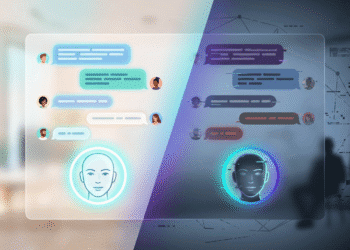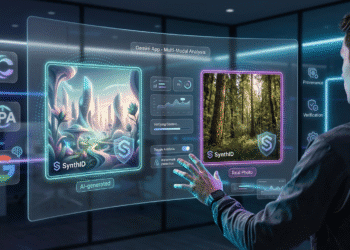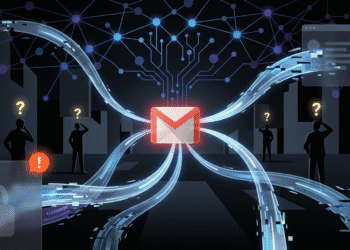A Breakthrough in Brain-Computer Technology Brings Us Closer to Digital Telepathy
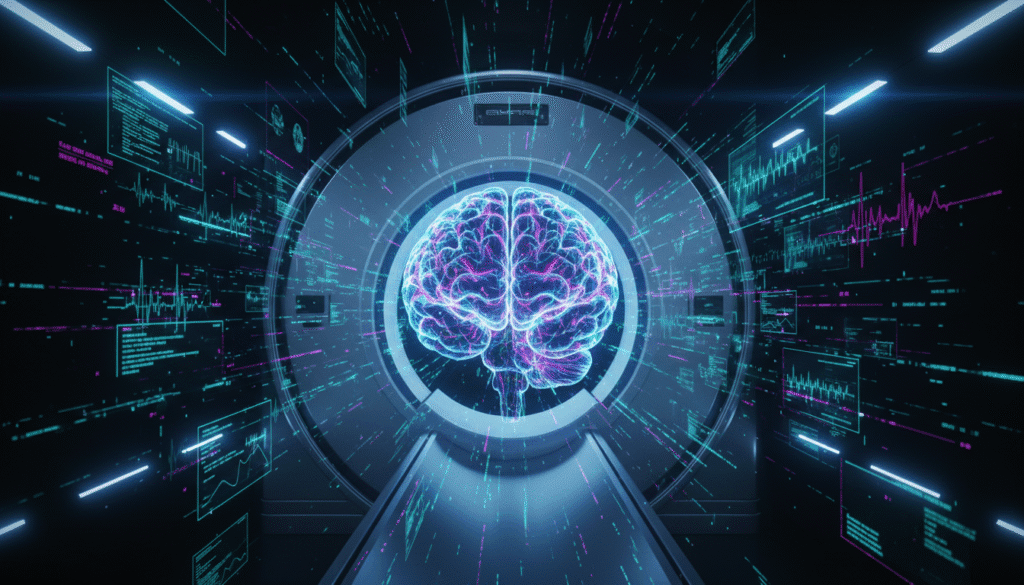
Imagine this: you’re watching a video of someone jumping off a waterfall. Meanwhile, a computer is quietly analyzing your brain activity. Moments later, it spits out a sentence describing exactly what you just saw without you saying a word. Sounds like science fiction, right? Well, it’s not anymore.
Scientists have just developed a groundbreaking technology called “mind captioning” that can turn your brain activity into detailed text descriptions of what you’re thinking. It’s essentially digital mind-reading, and it’s both fascinating and a little unsettling.
Developed by researchers from the University of California, Berkeley, and Japan’s NTT Communication Science Laboratories, this technology combines artificial intelligence models with MRI brain scans to decode thoughts. The implications are massive from helping people with speech disabilities communicate to raising serious questions about mental privacy in our increasingly surveilled world.
How Does Mind Captioning Actually Work?
The process behind this technology is surprisingly complex. It’s not just one AI doing all the work it’s actually a sophisticated chain of multiple artificial intelligence models working together.
First, researchers trained an AI model on over 2,000 short video clips. The model learned to pair visual content with written captions, creating what the team calls a “meaning signature” for each clip. Think of it as a digital fingerprint of the video’s narrative.
Then comes the clever part. Another AI was trained to match those meaning signatures to actual brain scans from volunteers who watched the same videos. Six participants spent nearly seventeen hours each in an MRI scanner, watching thousands of short clips ranging from playful animals to emotional interactions and everyday moments.
Once trained, the brain decoder could analyze a new brain scan from someone watching a video and predict the meaning signature. Then a third AI text generator would search for sentences that matched the predicted signature, creating dozens of candidate descriptions and refining them along the way.
“This is hard to do,” says Alex Huth, a computational neuroscientist at UC Berkeley. “It’s surprising you can get that much detail.”
The Waterfall Test: How Accurate Is It?
So how well does this mind-reading AI actually work? Pretty impressively, it turns out.
In one test, a participant watched a video of someone leaping off a waterfall. The AI’s first guess was simply “spring flow.” Not great. But after a few refinements, it progressed to “above rapid falling water fall” on the tenth guess. By the 100th iteration, it had landed on “a person jumps over a deep water fall on a mountain ridge.”
Not perfect, but remarkably close!
Across multiple trials, the system correctly identified the correct video from 100 options about half the time. That might not sound like much, but consider this: random chance would give you about a one percent success rate. Fifty percent accuracy is actually quite impressive when you’re essentially divining coherent thoughts from brain patterns.
The researchers also discovered something fascinating when they scrambled the word order of the generated captions. The quality and accuracy dropped sharply. This showed that the AI wasn’t just picking up on keywords it was grasping something deeper. Perhaps the structure of meaning itself, the relationships between objects, actions, and context.
It Can Read Your Memories Too
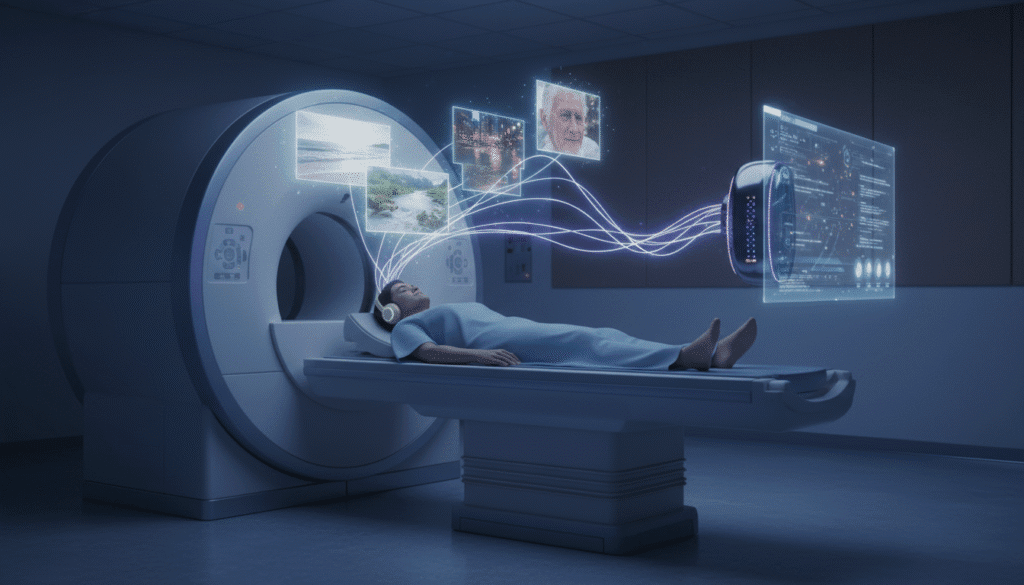
Here’s where things get really interesting. The technology isn’t limited to real-time observation.
In a follow-up experiment, volunteers were asked to recall videos they’d previously watched rather than viewing them again. They closed their eyes, imagined the scenes, and rated how vivid their mental replay felt. The same model, trained only on perception data, was used to decode these recollections.
Astonishingly, it still worked.
Even when subjects were only imagining the videos, the AI generated accurate sentences describing them, sometimes identifying the right clip out of a hundred. This result hints at a powerful idea: the brain uses similar representations for seeing and remembering, and those representations can be translated into language.
What’s even more surprising? When researchers deliberately excluded brain regions typically associated with language processing, the system continued to generate coherent text. This suggests that structured meaning what scientists call “semantic representation” is distributed widely across the brain, not confined to speech-related zones.
A Lifeline for People Who Can’t Speak
The potential medical applications of this technology are enormous.
Think about people who’ve suffered strokes, those living with aphasia, or individuals with neurodegenerative diseases that affect language. For them, words are trapped inside their minds, unable to escape. This technology could provide a way out.
“If we can do that using these artificial systems, maybe we can help out these people with communication difficulties,” Huth told Nature.
The paper describes the system as an “interpretive interface” that could restore communication for those whose ability to speak has been stolen by illness or injury. Imagine being able to communicate just by thinking, without needing to move your mouth or hands. For millions of people worldwide, this could be life-changing.
Currently, people with severe speech disabilities often rely on eye-tracking devices or brain-computer interfaces that require invasive surgery. This new approach, while still requiring an MRI scanner, is completely non-invasive. And researchers hope that future versions could work with brain implants, making the technology more practical for daily use.
The Privacy Nightmare We Need to Talk About
But here’s the uncomfortable question: if machines can turn brain activity into words, who controls that information?
The ethical implications are staggering. Could this technology be misused for surveillance or law enforcement use it to extract confessions? Is it possible for advertisers use it to probe your deepest desires and fears? Could authoritarian governments use it to detect dissent before it’s even spoken?
These aren’t just paranoid fantasies. History has shown us that every new surveillance technology eventually gets pushed beyond its original purpose.
Both Horikawa and Huth have stressed the importance of consent and privacy. They’re quick to point out that the technology can’t actually read your private thoughts at least not yet. The model needs your cooperation, hours of personalized training data, and a massive MRI scanner to function. Your dirty secrets are safe… for now.
“Nobody has shown you can do that, yet,” Huth reassured Nature.
That word “yet” is doing a lot of heavy lifting in that sentence.
What Makes This Different from Previous Attempts?
This isn’t the first time scientists have tried to decode brain activity. But previous attempts had significant limitations.
Earlier systems could only produce crude descriptions using key words instead of providing detailed context. They might identify that you were looking at “water” and “person,” but couldn’t tell you that “a person jumps over a deep water fall on a mountain ridge.”
Other attempts used AI models to directly form sentences, which blurred the lines between what the person was actually thinking and what was AI-generated. It was like playing a game of telephone with your brain the message got garbled along the way.
Some techniques were wildly impractical. Meta, for example, created a device that lets you type text with your brain by combining a deep learning AI model with a magnetoencephalography scanner. But such a machine is both prohibitively expensive and large, and can only be used inside a room shielded from the Earth’s magnetic field. Not exactly something you can carry in your pocket.
What makes this new approach special is its transparency and accuracy. Instead of using deep, opaque neural networks, the researchers relied on a more transparent linear model. This model could reveal which regions of the brain contributed to which kinds of semantic information.
The Language of Thought
One of the most profound discoveries from this research is what it reveals about how our brains work.
The fact that the system could generate accurate descriptions even when language-processing regions were excluded suggests something remarkable: structured meaning exists in our brains independent of language itself. We think in concepts and relationships before we ever put those thoughts into words.
This challenges some long-held assumptions about how the brain processes information. It suggests that meaning isn’t created when we speak or write it exists before that, in a form that’s more abstract and fundamental.
As Tomoyasu Horikawa, the lead researcher from NTT Communication Science Laboratories, explains, the system doesn’t reconstruct thoughts directly. Instead, it translates them through layers of AI interpretation. “To accurately characterize our primary contribution, it is essential to frame our method as an interpretive interface rather than a literal reconstruction of mental content,” the paper states.
The Road Ahead: Promise and Peril
So where does this technology go from here?
In the short term, it’s confined to the lab. You need a handful of subjects, a room-sized MRI scanner, and a process that takes hours to calibrate. It’s not like someone can just point a device at your head and read your thoughts on the subway.
But the direction is unmistakable. Technology always gets smaller, faster, and more accessible. What requires a massive MRI machine today might work with a portable brain scanner tomorrow. What takes hours of training data now might need only minutes in the future.
The researchers are already thinking about combining their approach with brain implants, which could provide the necessary readings without requiring an MRI machine. Companies like Neuralink are already working on brain-computer interfaces that could potentially be adapted for this purpose.
The potential benefits are enormous. Beyond helping people with speech disabilities, this technology could revolutionize how we interact with computers, how we communicate with each other, and how we understand the human mind itself.
But the risks are equally significant. As the technology advances, concerns about mental privacy, informed consent, and potential abuse will only intensify. We need to have serious conversations about how this technology should be regulated, who should have access to it, and what safeguards need to be in place.
The Future Is Closer Than You Think
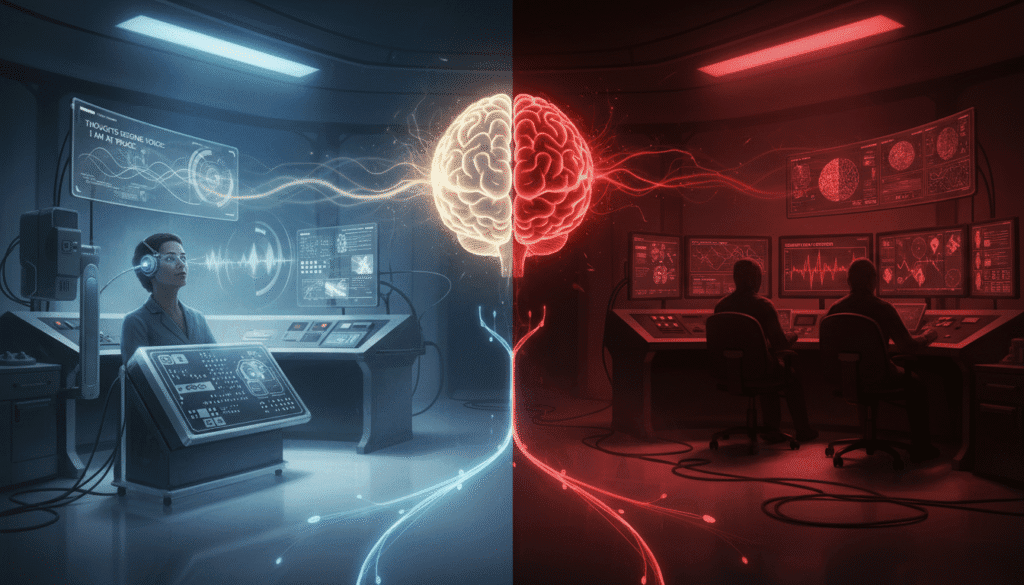
We’re rapidly barreling toward a world where mind-reading is real. Not the Professor X kind, where someone holds two fingers to their temples and closes their eyes. But something perhaps more powerful and more concerning.
The technology described in Science Advances represents a significant step toward that future. It’s not perfect. It’s not portable. It can’t read your deepest, darkest secrets. But it’s a proof of concept that shows what’s possible.
As with any powerful technology, the question isn’t whether we can do it clearly, we can. The question is whether we should, and if so, how we ensure it’s used responsibly.
For now, your thoughts remain your own. But “for now” might not last as long as we’d like to think.
The age of digital telepathy is dawning. Whether that’s a blessing or a curse depends entirely on what we do next.
Sources
- Scientists Just Built an AI That Can Basically Read Your Mind – VICE
- Scientists develop AI that can read your mind and print out what you’re thinking – Mirror
- Scientists have just created an AI that can basically read your mind – End Time Headlines
- ‘Mind-captioning’ AI decodes brain activity to turn thoughts into text – Nature
- AI Decodes Visual Brain Activity—And Writes Captions for It – Scientific American
- Scientists Say They’ve Figured Out How to Transcribe Your Thoughts From an MRI Scan – Futurism
- Mind Captioning: Generating Descriptive Text from Brain Activity – Science Advances


